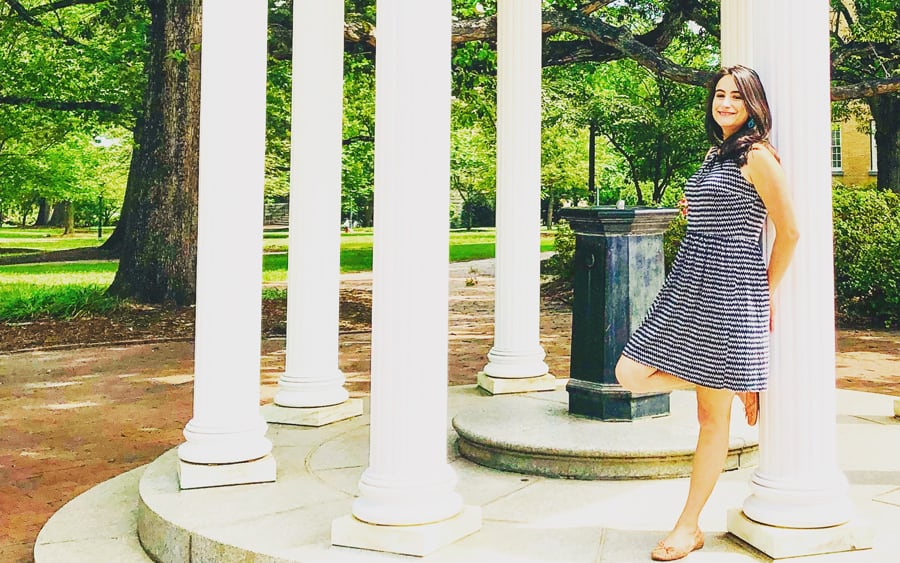Gemischte Gefühle: Leben mit seltenen CF-Mutationen
From time to time we invite guest bloggers who are part of the Emily’s Entourage (EE) community to contribute their unique voices to our blog. In honor of May being Cystic Fibrosis (CF) Awareness Month, we are shining a light on people directly affected by CF in our #CFStrong series. Today’s guest is Miriam Figueira who blends multiple worlds as both a CF scientist and a person with CF.
I am not eligible to take the breakthrough triple-combination therapy (TRIKAFTA™) currently available for 90% of the Cystic Fibrosis (CF) community because of my rare CF mutations. This makes me feel a lot of fluctuating emotions that are hard to express, but I would like to bring a voice to those in a similar situation by telling my story and sharing important information everyone should know about CF rare mutations.

Before getting into my personal story, I want to highlight crucial points to help those better understand CF rare mutations:
- The “final 10%” refers to the CF population in the US that is not eligible for the new modulator treatments, including TRIKAFTA™. Yet, in other countries, the number of patients that do not qualify can be higher, reaching up to 50% of the CF population.
- As it is with every drug, part of those eligible patients will not be able to take modulators due to severe side effects, lack of response, or other reasons. Alternative treatments will be necessary for this group too.
- The primary non-eligible patients are those with two mutations, either Class 1 or a non-F508del Class 2 variant. [Editor’s note: There are over 1,800 different genetic mutations of CF. The mutations are grouped into 6 categories (Class 1-6) based on the type of genetic defect.]
- Class 1 encompasses different types of mutations, including splicing, frame-shift, and nonsense mutations. Some scientists do not expect Class 1 mutations to respond to any modulators because they do not produce a functional protein to modulate. Therefore, Class 1 mutations may need alternative treatments to address their defects, such as mRNA therapy or the potentiation of alternatives chloride channels. Readthrough agents are also a possibility designed specifically for nonsense mutations within the Class 1 category.
- Class 2 mutations include F508del, the most common CF mutation, and have the potential to respond to a modulator therapy like TRIKAFTA™. Many other Class 2 variants can potentially be treated by TRIKAFTA™ or other modulators. All the different Class 2 mutations should also be screened for new modulator compounds.
I need to highlight as well how I feel happy to see my CF peers (on the new modulator therapies) getting healthier than ever. It is an incredible joy that comes with an uncontrolled sadness to not be able to join them.
“Feeling isolated from your peers with the same disease you have is a hard thing to endure. In addition, the thought of losing your ability to breathe over time and having more difficult infections as you age is daunting and an excruciating challenge that I still have to live with, especially without near-term hope in sight.”
My story with modulators started in 2015 when I participated in a trial for the first modulator therapy developed, called KALYDECO®. During the trial, my hope became gigantic, it got out of my control, and I even had a significant placebo effect. However, after the trial ended, I learned that KALYDECO® had not worked for me and my mutations had no residual function. After having such high expectations and then experiencing no benefits from the experimental treatment, I fell into a terrible and hopeless state of mind. Feeling isolated from your peers with the same disease you have is a hard thing to endure. In addition, the thought of losing your ability to breathe over time and having more difficult infections as you age is daunting and an excruciating challenge that I still have to live with, especially without near-term hope in sight.
After a lot of setbacks and psychotherapy, I got my spirit back on track again. I know deep down that having a rare disease with rare mutations will always be a sensitive topic for me. However, now I can see that I used this disappointment to build something fruitful. Taking part in this trial helped me decide to focus my already initiated career in science on CF research. I did a PhD focused on CF, and currently, I am doing a postdoc focused precisely on what gives me conflicting feelings: modulators.

Even though I am not eligible for any current modulators, I am still fascinated by them from a scientific point of view and as a hopeful patient. I want to continue bringing more knowledge about modulators and CF into the world. Part of my work is testing different modulators on CF patients’ cells. It is incredible to be able to see with my own eyes how the advances are coming to fruition and helping so many patients! I feel joy to be part of this process because I understand how important they are! These achievements also make me believe more strongly that we need an advance like this for all of us with CF.
In my case, I have a Class 1 and a Class 2 mutation (G85E), so I keep hoping that a new modulator can also help my Class 2 mutation. I am also so hopeful about the therapies that can work for all mutations. When people talk about not giving up until a potential treatment includes 100% of patients, it uplifts my heart! The incredible efforts of Emily’s Entourage in funding groundbreaking research to achieve 100% of the community is so encouraging and gives us hope that we will not be left behind.
Let’s use our empathy to spread the word and bring awareness to rare mutations. CF patients with rare mutations are hopeful, desperate, and they count!
An earlier version of this blog was published on CF Roundtable and has been shared here with permission. To read the version published on CF Roundtable, please click hier.
